Organisational Behaviour: Structure, Culture, and Leadership
VerifiedAdded on 2020/01/21
|14
|4800
|185
Report
AI Summary
This report delves into the multifaceted realm of organisational behaviour, examining the interplay of structure, culture, and leadership within two distinct organisations: City College and Rent-a-Car Enterprise. The report begins by comparing and contrasting organisational structures and cultures, highlighting their impact on business performance. It then explores the influence of various factors on individual behaviour in the workplace. The analysis extends to evaluating the effectiveness of different leadership styles, organisational theories underpinning management practices, and contrasting management approaches employed by each organisation. Furthermore, the report investigates the effects of leadership styles on employee motivation, comparing motivational theories and their practical applications. The final section examines group dynamics, teamwork development, and the impact of technology on team functioning, providing a comprehensive overview of organisational behaviour principles.
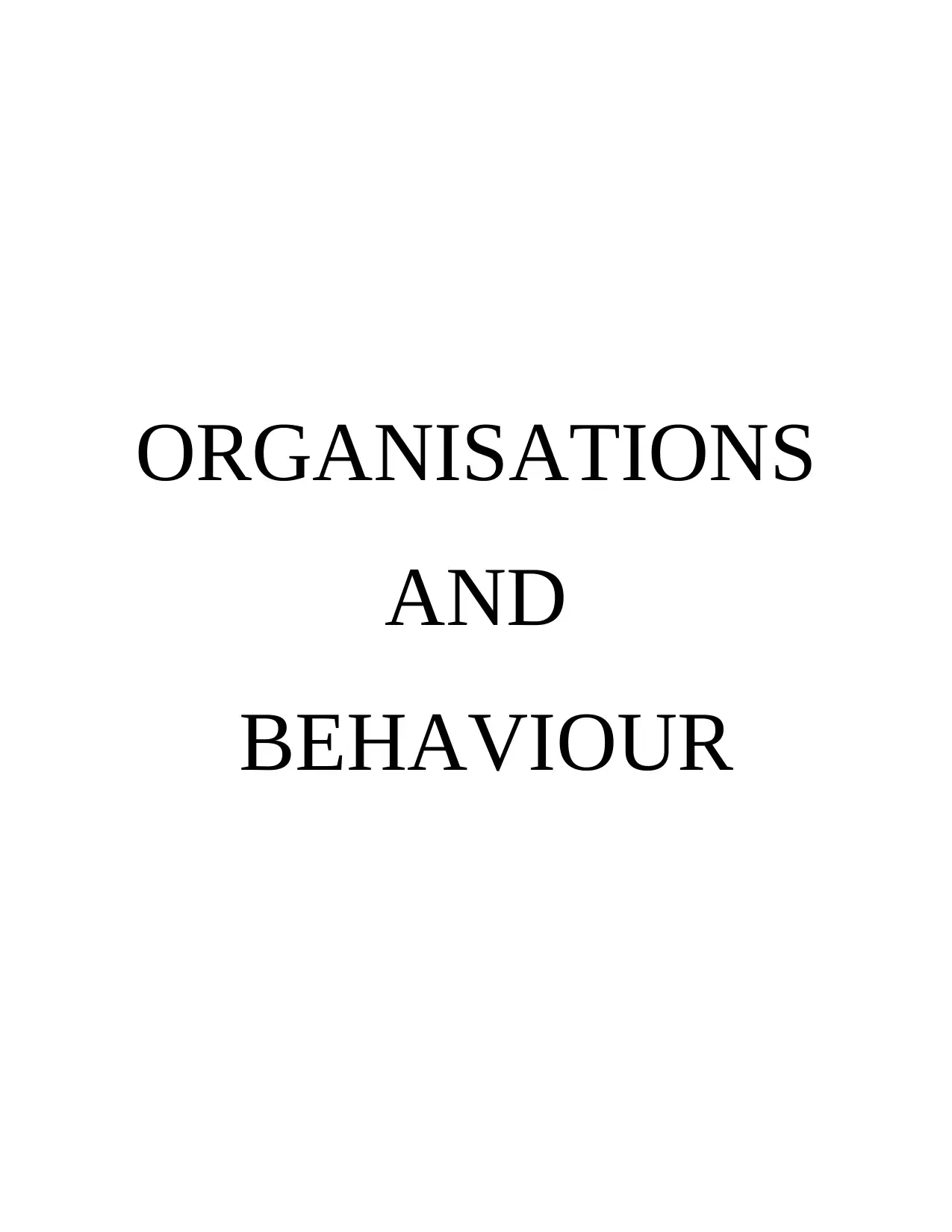
ORGANISATIONS
AND
BEHAVIOUR
AND
BEHAVIOUR
Paraphrase This Document
Need a fresh take? Get an instant paraphrase of this document with our AI Paraphraser
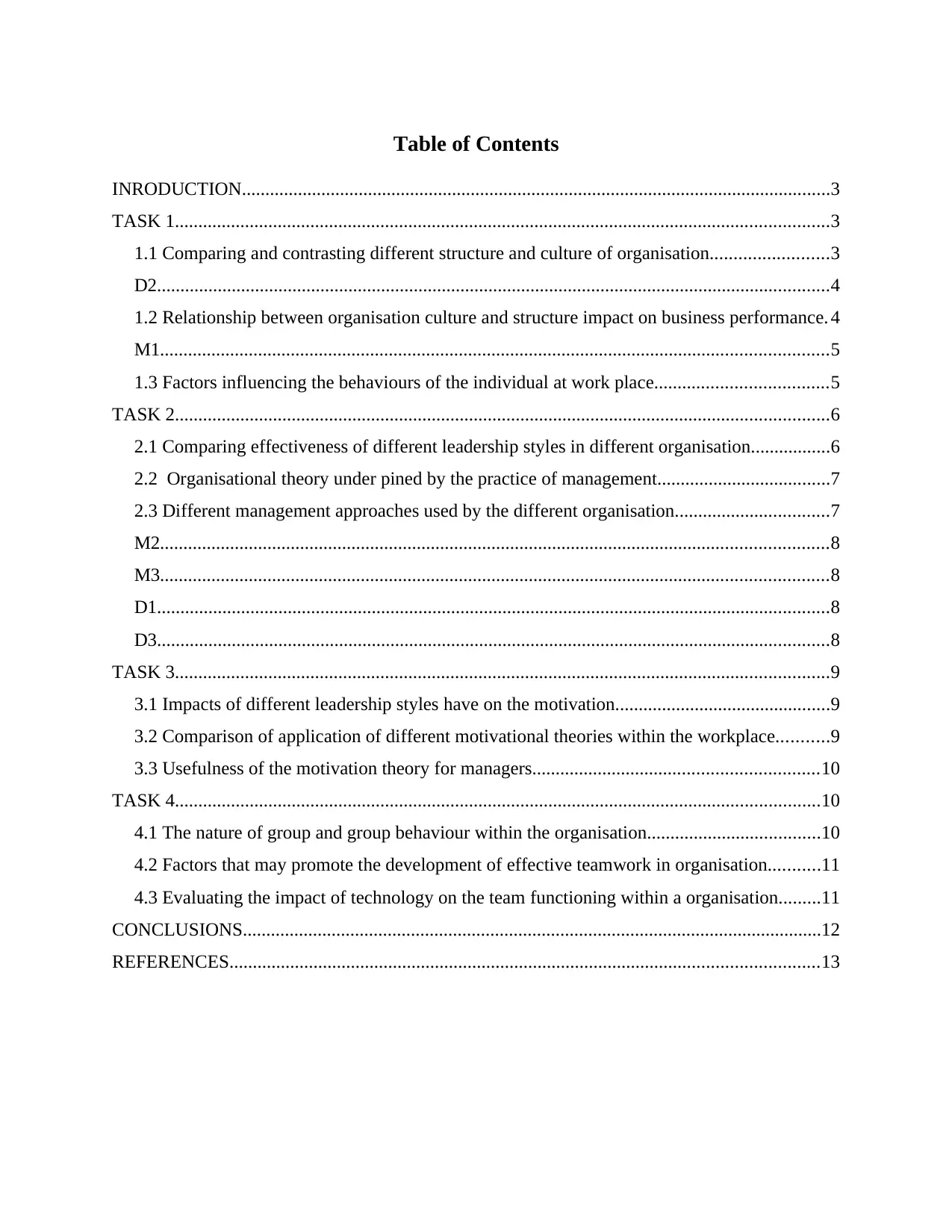
Table of Contents
INRODUCTION..............................................................................................................................3
TASK 1............................................................................................................................................3
1.1 Comparing and contrasting different structure and culture of organisation.........................3
D2................................................................................................................................................4
1.2 Relationship between organisation culture and structure impact on business performance. 4
M1...............................................................................................................................................5
1.3 Factors influencing the behaviours of the individual at work place.....................................5
TASK 2............................................................................................................................................6
2.1 Comparing effectiveness of different leadership styles in different organisation.................6
2.2 Organisational theory under pined by the practice of management.....................................7
2.3 Different management approaches used by the different organisation.................................7
M2...............................................................................................................................................8
M3...............................................................................................................................................8
D1................................................................................................................................................8
D3................................................................................................................................................8
TASK 3............................................................................................................................................9
3.1 Impacts of different leadership styles have on the motivation..............................................9
3.2 Comparison of application of different motivational theories within the workplace...........9
3.3 Usefulness of the motivation theory for managers.............................................................10
TASK 4..........................................................................................................................................10
4.1 The nature of group and group behaviour within the organisation.....................................10
4.2 Factors that may promote the development of effective teamwork in organisation...........11
4.3 Evaluating the impact of technology on the team functioning within a organisation.........11
CONCLUSIONS............................................................................................................................12
REFERENCES..............................................................................................................................13
INRODUCTION..............................................................................................................................3
TASK 1............................................................................................................................................3
1.1 Comparing and contrasting different structure and culture of organisation.........................3
D2................................................................................................................................................4
1.2 Relationship between organisation culture and structure impact on business performance. 4
M1...............................................................................................................................................5
1.3 Factors influencing the behaviours of the individual at work place.....................................5
TASK 2............................................................................................................................................6
2.1 Comparing effectiveness of different leadership styles in different organisation.................6
2.2 Organisational theory under pined by the practice of management.....................................7
2.3 Different management approaches used by the different organisation.................................7
M2...............................................................................................................................................8
M3...............................................................................................................................................8
D1................................................................................................................................................8
D3................................................................................................................................................8
TASK 3............................................................................................................................................9
3.1 Impacts of different leadership styles have on the motivation..............................................9
3.2 Comparison of application of different motivational theories within the workplace...........9
3.3 Usefulness of the motivation theory for managers.............................................................10
TASK 4..........................................................................................................................................10
4.1 The nature of group and group behaviour within the organisation.....................................10
4.2 Factors that may promote the development of effective teamwork in organisation...........11
4.3 Evaluating the impact of technology on the team functioning within a organisation.........11
CONCLUSIONS............................................................................................................................12
REFERENCES..............................................................................................................................13
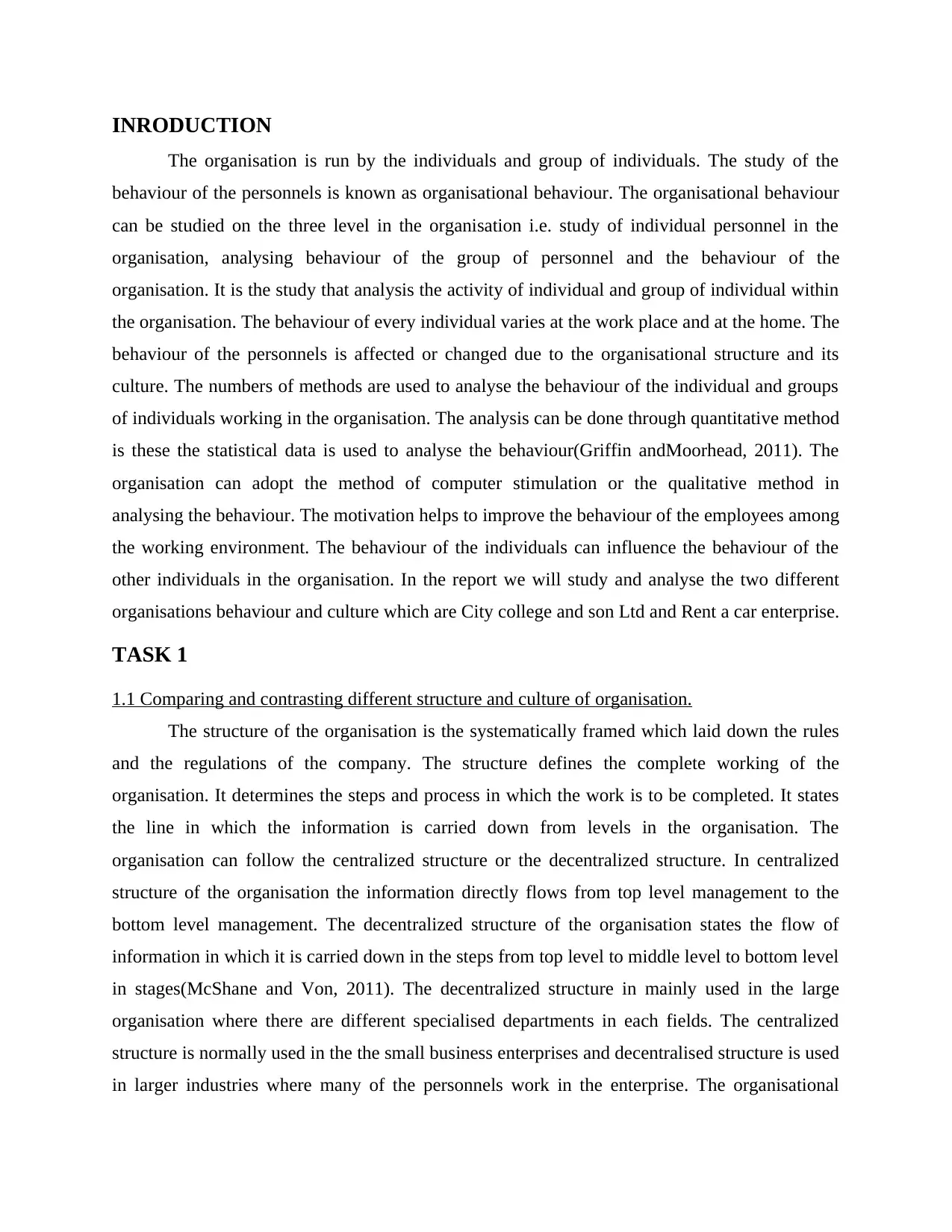
INRODUCTION
The organisation is run by the individuals and group of individuals. The study of the
behaviour of the personnels is known as organisational behaviour. The organisational behaviour
can be studied on the three level in the organisation i.e. study of individual personnel in the
organisation, analysing behaviour of the group of personnel and the behaviour of the
organisation. It is the study that analysis the activity of individual and group of individual within
the organisation. The behaviour of every individual varies at the work place and at the home. The
behaviour of the personnels is affected or changed due to the organisational structure and its
culture. The numbers of methods are used to analyse the behaviour of the individual and groups
of individuals working in the organisation. The analysis can be done through quantitative method
is these the statistical data is used to analyse the behaviour(Griffin andMoorhead, 2011). The
organisation can adopt the method of computer stimulation or the qualitative method in
analysing the behaviour. The motivation helps to improve the behaviour of the employees among
the working environment. The behaviour of the individuals can influence the behaviour of the
other individuals in the organisation. In the report we will study and analyse the two different
organisations behaviour and culture which are City college and son Ltd and Rent a car enterprise.
TASK 1
1.1 Comparing and contrasting different structure and culture of organisation.
The structure of the organisation is the systematically framed which laid down the rules
and the regulations of the company. The structure defines the complete working of the
organisation. It determines the steps and process in which the work is to be completed. It states
the line in which the information is carried down from levels in the organisation. The
organisation can follow the centralized structure or the decentralized structure. In centralized
structure of the organisation the information directly flows from top level management to the
bottom level management. The decentralized structure of the organisation states the flow of
information in which it is carried down in the steps from top level to middle level to bottom level
in stages(McShane and Von, 2011). The decentralized structure in mainly used in the large
organisation where there are different specialised departments in each fields. The centralized
structure is normally used in the the small business enterprises and decentralised structure is used
in larger industries where many of the personnels work in the enterprise. The organisational
The organisation is run by the individuals and group of individuals. The study of the
behaviour of the personnels is known as organisational behaviour. The organisational behaviour
can be studied on the three level in the organisation i.e. study of individual personnel in the
organisation, analysing behaviour of the group of personnel and the behaviour of the
organisation. It is the study that analysis the activity of individual and group of individual within
the organisation. The behaviour of every individual varies at the work place and at the home. The
behaviour of the personnels is affected or changed due to the organisational structure and its
culture. The numbers of methods are used to analyse the behaviour of the individual and groups
of individuals working in the organisation. The analysis can be done through quantitative method
is these the statistical data is used to analyse the behaviour(Griffin andMoorhead, 2011). The
organisation can adopt the method of computer stimulation or the qualitative method in
analysing the behaviour. The motivation helps to improve the behaviour of the employees among
the working environment. The behaviour of the individuals can influence the behaviour of the
other individuals in the organisation. In the report we will study and analyse the two different
organisations behaviour and culture which are City college and son Ltd and Rent a car enterprise.
TASK 1
1.1 Comparing and contrasting different structure and culture of organisation.
The structure of the organisation is the systematically framed which laid down the rules
and the regulations of the company. The structure defines the complete working of the
organisation. It determines the steps and process in which the work is to be completed. It states
the line in which the information is carried down from levels in the organisation. The
organisation can follow the centralized structure or the decentralized structure. In centralized
structure of the organisation the information directly flows from top level management to the
bottom level management. The decentralized structure of the organisation states the flow of
information in which it is carried down in the steps from top level to middle level to bottom level
in stages(McShane and Von, 2011). The decentralized structure in mainly used in the large
organisation where there are different specialised departments in each fields. The centralized
structure is normally used in the the small business enterprises and decentralised structure is used
in larger industries where many of the personnels work in the enterprise. The organisational
⊘ This is a preview!⊘
Do you want full access?
Subscribe today to unlock all pages.

Trusted by 1+ million students worldwide
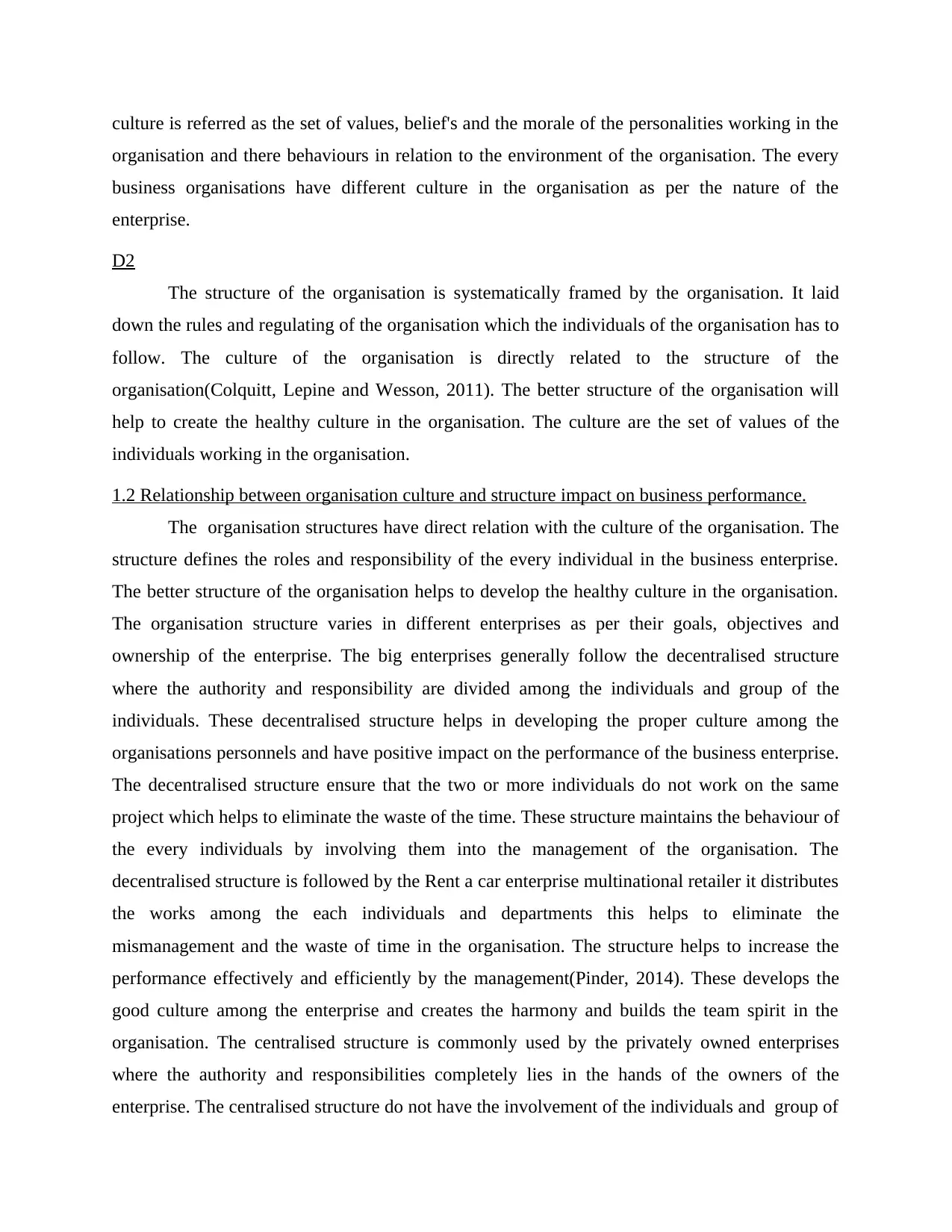
culture is referred as the set of values, belief's and the morale of the personalities working in the
organisation and there behaviours in relation to the environment of the organisation. The every
business organisations have different culture in the organisation as per the nature of the
enterprise.
D2
The structure of the organisation is systematically framed by the organisation. It laid
down the rules and regulating of the organisation which the individuals of the organisation has to
follow. The culture of the organisation is directly related to the structure of the
organisation(Colquitt, Lepine and Wesson, 2011). The better structure of the organisation will
help to create the healthy culture in the organisation. The culture are the set of values of the
individuals working in the organisation.
1.2 Relationship between organisation culture and structure impact on business performance.
The organisation structures have direct relation with the culture of the organisation. The
structure defines the roles and responsibility of the every individual in the business enterprise.
The better structure of the organisation helps to develop the healthy culture in the organisation.
The organisation structure varies in different enterprises as per their goals, objectives and
ownership of the enterprise. The big enterprises generally follow the decentralised structure
where the authority and responsibility are divided among the individuals and group of the
individuals. These decentralised structure helps in developing the proper culture among the
organisations personnels and have positive impact on the performance of the business enterprise.
The decentralised structure ensure that the two or more individuals do not work on the same
project which helps to eliminate the waste of the time. These structure maintains the behaviour of
the every individuals by involving them into the management of the organisation. The
decentralised structure is followed by the Rent a car enterprise multinational retailer it distributes
the works among the each individuals and departments this helps to eliminate the
mismanagement and the waste of time in the organisation. The structure helps to increase the
performance effectively and efficiently by the management(Pinder, 2014). These develops the
good culture among the enterprise and creates the harmony and builds the team spirit in the
organisation. The centralised structure is commonly used by the privately owned enterprises
where the authority and responsibilities completely lies in the hands of the owners of the
enterprise. The centralised structure do not have the involvement of the individuals and group of
organisation and there behaviours in relation to the environment of the organisation. The every
business organisations have different culture in the organisation as per the nature of the
enterprise.
D2
The structure of the organisation is systematically framed by the organisation. It laid
down the rules and regulating of the organisation which the individuals of the organisation has to
follow. The culture of the organisation is directly related to the structure of the
organisation(Colquitt, Lepine and Wesson, 2011). The better structure of the organisation will
help to create the healthy culture in the organisation. The culture are the set of values of the
individuals working in the organisation.
1.2 Relationship between organisation culture and structure impact on business performance.
The organisation structures have direct relation with the culture of the organisation. The
structure defines the roles and responsibility of the every individual in the business enterprise.
The better structure of the organisation helps to develop the healthy culture in the organisation.
The organisation structure varies in different enterprises as per their goals, objectives and
ownership of the enterprise. The big enterprises generally follow the decentralised structure
where the authority and responsibility are divided among the individuals and group of the
individuals. These decentralised structure helps in developing the proper culture among the
organisations personnels and have positive impact on the performance of the business enterprise.
The decentralised structure ensure that the two or more individuals do not work on the same
project which helps to eliminate the waste of the time. These structure maintains the behaviour of
the every individuals by involving them into the management of the organisation. The
decentralised structure is followed by the Rent a car enterprise multinational retailer it distributes
the works among the each individuals and departments this helps to eliminate the
mismanagement and the waste of time in the organisation. The structure helps to increase the
performance effectively and efficiently by the management(Pinder, 2014). These develops the
good culture among the enterprise and creates the harmony and builds the team spirit in the
organisation. The centralised structure is commonly used by the privately owned enterprises
where the authority and responsibilities completely lies in the hands of the owners of the
enterprise. The centralised structure do not have the involvement of the individuals and group of
Paraphrase This Document
Need a fresh take? Get an instant paraphrase of this document with our AI Paraphraser
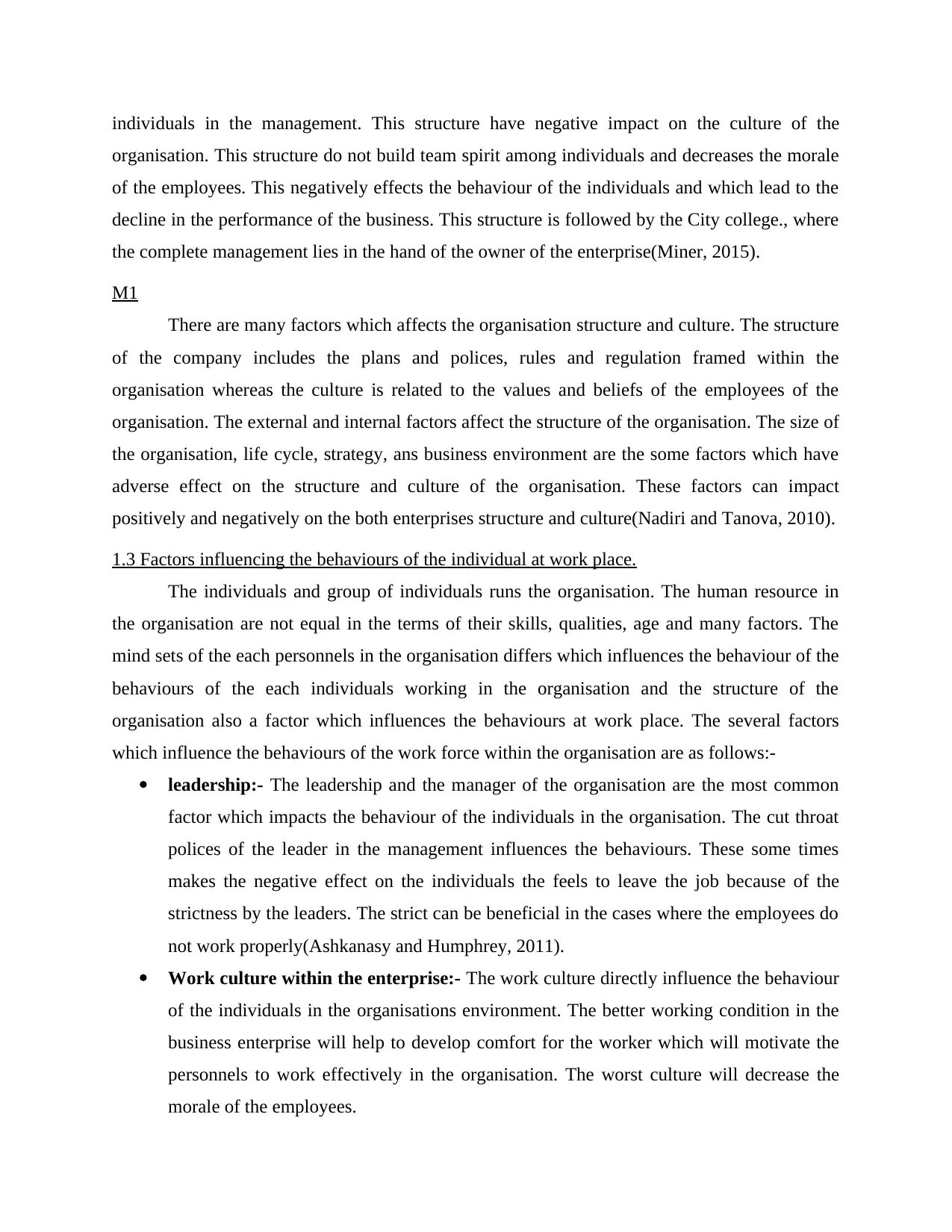
individuals in the management. This structure have negative impact on the culture of the
organisation. This structure do not build team spirit among individuals and decreases the morale
of the employees. This negatively effects the behaviour of the individuals and which lead to the
decline in the performance of the business. This structure is followed by the City college., where
the complete management lies in the hand of the owner of the enterprise(Miner, 2015).
M1
There are many factors which affects the organisation structure and culture. The structure
of the company includes the plans and polices, rules and regulation framed within the
organisation whereas the culture is related to the values and beliefs of the employees of the
organisation. The external and internal factors affect the structure of the organisation. The size of
the organisation, life cycle, strategy, ans business environment are the some factors which have
adverse effect on the structure and culture of the organisation. These factors can impact
positively and negatively on the both enterprises structure and culture(Nadiri and Tanova, 2010).
1.3 Factors influencing the behaviours of the individual at work place.
The individuals and group of individuals runs the organisation. The human resource in
the organisation are not equal in the terms of their skills, qualities, age and many factors. The
mind sets of the each personnels in the organisation differs which influences the behaviour of the
behaviours of the each individuals working in the organisation and the structure of the
organisation also a factor which influences the behaviours at work place. The several factors
which influence the behaviours of the work force within the organisation are as follows:-
leadership:- The leadership and the manager of the organisation are the most common
factor which impacts the behaviour of the individuals in the organisation. The cut throat
polices of the leader in the management influences the behaviours. These some times
makes the negative effect on the individuals the feels to leave the job because of the
strictness by the leaders. The strict can be beneficial in the cases where the employees do
not work properly(Ashkanasy and Humphrey, 2011).
Work culture within the enterprise:- The work culture directly influence the behaviour
of the individuals in the organisations environment. The better working condition in the
business enterprise will help to develop comfort for the worker which will motivate the
personnels to work effectively in the organisation. The worst culture will decrease the
morale of the employees.
organisation. This structure do not build team spirit among individuals and decreases the morale
of the employees. This negatively effects the behaviour of the individuals and which lead to the
decline in the performance of the business. This structure is followed by the City college., where
the complete management lies in the hand of the owner of the enterprise(Miner, 2015).
M1
There are many factors which affects the organisation structure and culture. The structure
of the company includes the plans and polices, rules and regulation framed within the
organisation whereas the culture is related to the values and beliefs of the employees of the
organisation. The external and internal factors affect the structure of the organisation. The size of
the organisation, life cycle, strategy, ans business environment are the some factors which have
adverse effect on the structure and culture of the organisation. These factors can impact
positively and negatively on the both enterprises structure and culture(Nadiri and Tanova, 2010).
1.3 Factors influencing the behaviours of the individual at work place.
The individuals and group of individuals runs the organisation. The human resource in
the organisation are not equal in the terms of their skills, qualities, age and many factors. The
mind sets of the each personnels in the organisation differs which influences the behaviour of the
behaviours of the each individuals working in the organisation and the structure of the
organisation also a factor which influences the behaviours at work place. The several factors
which influence the behaviours of the work force within the organisation are as follows:-
leadership:- The leadership and the manager of the organisation are the most common
factor which impacts the behaviour of the individuals in the organisation. The cut throat
polices of the leader in the management influences the behaviours. These some times
makes the negative effect on the individuals the feels to leave the job because of the
strictness by the leaders. The strict can be beneficial in the cases where the employees do
not work properly(Ashkanasy and Humphrey, 2011).
Work culture within the enterprise:- The work culture directly influence the behaviour
of the individuals in the organisations environment. The better working condition in the
business enterprise will help to develop comfort for the worker which will motivate the
personnels to work effectively in the organisation. The worst culture will decrease the
morale of the employees.
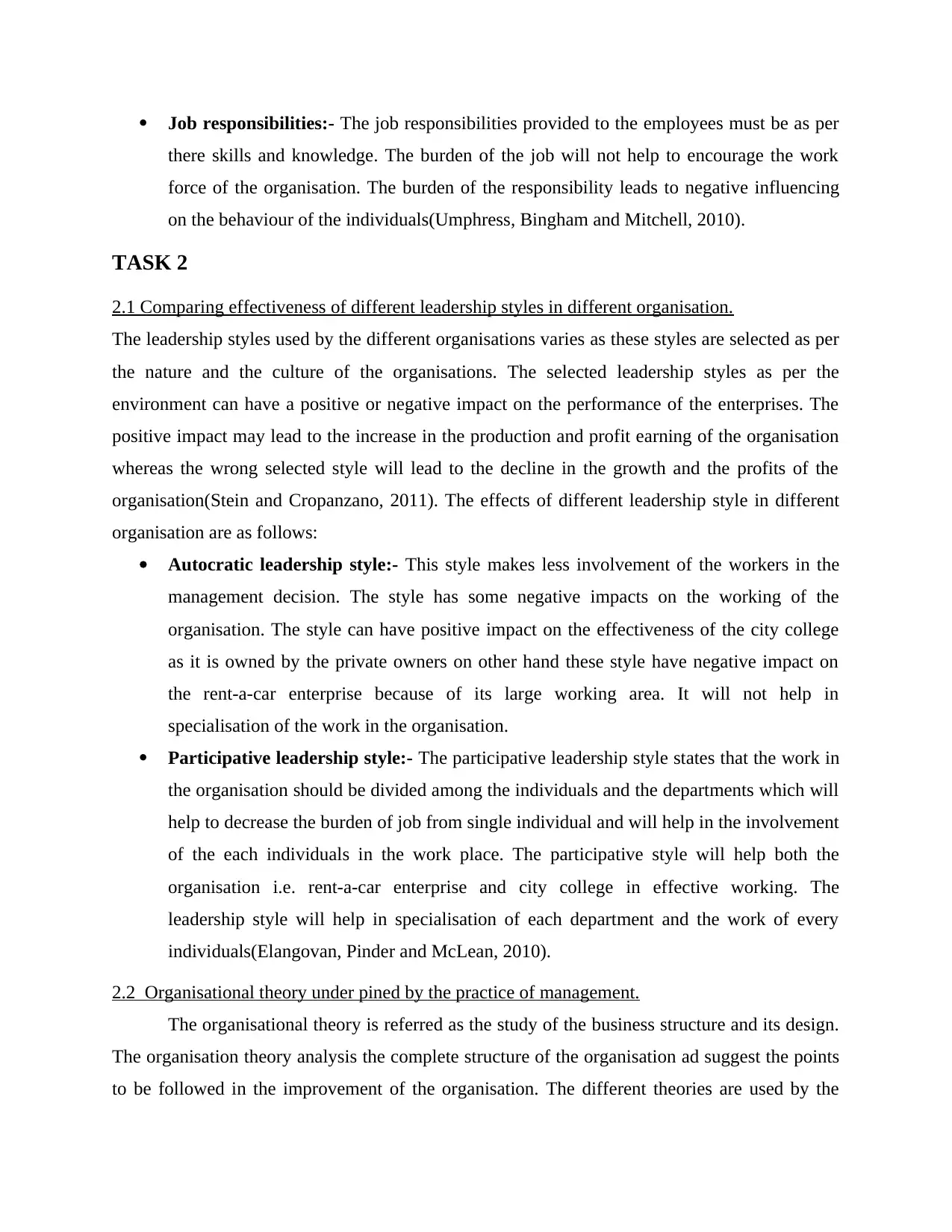
Job responsibilities:- The job responsibilities provided to the employees must be as per
there skills and knowledge. The burden of the job will not help to encourage the work
force of the organisation. The burden of the responsibility leads to negative influencing
on the behaviour of the individuals(Umphress, Bingham and Mitchell, 2010).
TASK 2
2.1 Comparing effectiveness of different leadership styles in different organisation.
The leadership styles used by the different organisations varies as these styles are selected as per
the nature and the culture of the organisations. The selected leadership styles as per the
environment can have a positive or negative impact on the performance of the enterprises. The
positive impact may lead to the increase in the production and profit earning of the organisation
whereas the wrong selected style will lead to the decline in the growth and the profits of the
organisation(Stein and Cropanzano, 2011). The effects of different leadership style in different
organisation are as follows:
Autocratic leadership style:- This style makes less involvement of the workers in the
management decision. The style has some negative impacts on the working of the
organisation. The style can have positive impact on the effectiveness of the city college
as it is owned by the private owners on other hand these style have negative impact on
the rent-a-car enterprise because of its large working area. It will not help in
specialisation of the work in the organisation.
Participative leadership style:- The participative leadership style states that the work in
the organisation should be divided among the individuals and the departments which will
help to decrease the burden of job from single individual and will help in the involvement
of the each individuals in the work place. The participative style will help both the
organisation i.e. rent-a-car enterprise and city college in effective working. The
leadership style will help in specialisation of each department and the work of every
individuals(Elangovan, Pinder and McLean, 2010).
2.2 Organisational theory under pined by the practice of management.
The organisational theory is referred as the study of the business structure and its design.
The organisation theory analysis the complete structure of the organisation ad suggest the points
to be followed in the improvement of the organisation. The different theories are used by the
there skills and knowledge. The burden of the job will not help to encourage the work
force of the organisation. The burden of the responsibility leads to negative influencing
on the behaviour of the individuals(Umphress, Bingham and Mitchell, 2010).
TASK 2
2.1 Comparing effectiveness of different leadership styles in different organisation.
The leadership styles used by the different organisations varies as these styles are selected as per
the nature and the culture of the organisations. The selected leadership styles as per the
environment can have a positive or negative impact on the performance of the enterprises. The
positive impact may lead to the increase in the production and profit earning of the organisation
whereas the wrong selected style will lead to the decline in the growth and the profits of the
organisation(Stein and Cropanzano, 2011). The effects of different leadership style in different
organisation are as follows:
Autocratic leadership style:- This style makes less involvement of the workers in the
management decision. The style has some negative impacts on the working of the
organisation. The style can have positive impact on the effectiveness of the city college
as it is owned by the private owners on other hand these style have negative impact on
the rent-a-car enterprise because of its large working area. It will not help in
specialisation of the work in the organisation.
Participative leadership style:- The participative leadership style states that the work in
the organisation should be divided among the individuals and the departments which will
help to decrease the burden of job from single individual and will help in the involvement
of the each individuals in the work place. The participative style will help both the
organisation i.e. rent-a-car enterprise and city college in effective working. The
leadership style will help in specialisation of each department and the work of every
individuals(Elangovan, Pinder and McLean, 2010).
2.2 Organisational theory under pined by the practice of management.
The organisational theory is referred as the study of the business structure and its design.
The organisation theory analysis the complete structure of the organisation ad suggest the points
to be followed in the improvement of the organisation. The different theories are used by the
⊘ This is a preview!⊘
Do you want full access?
Subscribe today to unlock all pages.

Trusted by 1+ million students worldwide
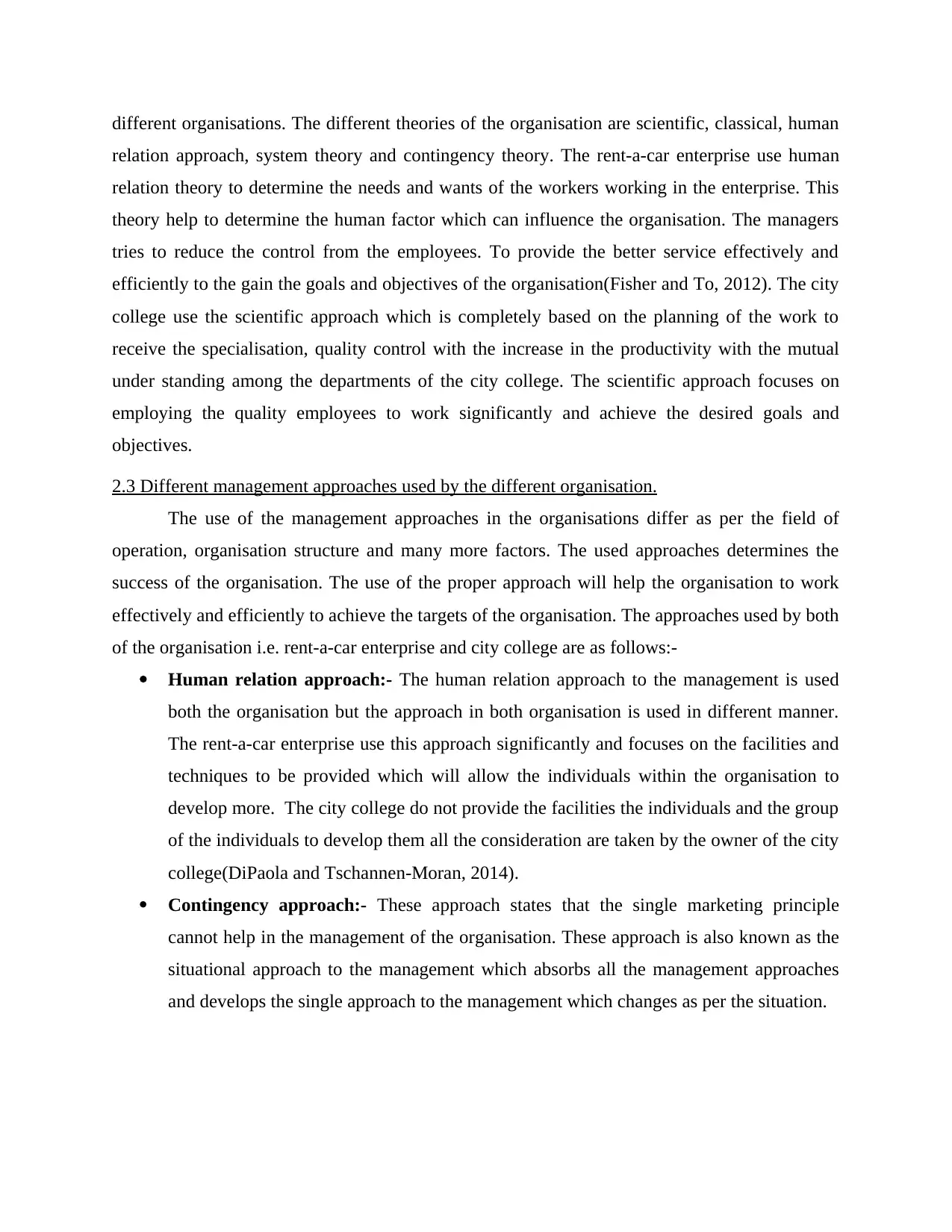
different organisations. The different theories of the organisation are scientific, classical, human
relation approach, system theory and contingency theory. The rent-a-car enterprise use human
relation theory to determine the needs and wants of the workers working in the enterprise. This
theory help to determine the human factor which can influence the organisation. The managers
tries to reduce the control from the employees. To provide the better service effectively and
efficiently to the gain the goals and objectives of the organisation(Fisher and To, 2012). The city
college use the scientific approach which is completely based on the planning of the work to
receive the specialisation, quality control with the increase in the productivity with the mutual
under standing among the departments of the city college. The scientific approach focuses on
employing the quality employees to work significantly and achieve the desired goals and
objectives.
2.3 Different management approaches used by the different organisation.
The use of the management approaches in the organisations differ as per the field of
operation, organisation structure and many more factors. The used approaches determines the
success of the organisation. The use of the proper approach will help the organisation to work
effectively and efficiently to achieve the targets of the organisation. The approaches used by both
of the organisation i.e. rent-a-car enterprise and city college are as follows:-
Human relation approach:- The human relation approach to the management is used
both the organisation but the approach in both organisation is used in different manner.
The rent-a-car enterprise use this approach significantly and focuses on the facilities and
techniques to be provided which will allow the individuals within the organisation to
develop more. The city college do not provide the facilities the individuals and the group
of the individuals to develop them all the consideration are taken by the owner of the city
college(DiPaola and Tschannen-Moran, 2014).
Contingency approach:- These approach states that the single marketing principle
cannot help in the management of the organisation. These approach is also known as the
situational approach to the management which absorbs all the management approaches
and develops the single approach to the management which changes as per the situation.
relation approach, system theory and contingency theory. The rent-a-car enterprise use human
relation theory to determine the needs and wants of the workers working in the enterprise. This
theory help to determine the human factor which can influence the organisation. The managers
tries to reduce the control from the employees. To provide the better service effectively and
efficiently to the gain the goals and objectives of the organisation(Fisher and To, 2012). The city
college use the scientific approach which is completely based on the planning of the work to
receive the specialisation, quality control with the increase in the productivity with the mutual
under standing among the departments of the city college. The scientific approach focuses on
employing the quality employees to work significantly and achieve the desired goals and
objectives.
2.3 Different management approaches used by the different organisation.
The use of the management approaches in the organisations differ as per the field of
operation, organisation structure and many more factors. The used approaches determines the
success of the organisation. The use of the proper approach will help the organisation to work
effectively and efficiently to achieve the targets of the organisation. The approaches used by both
of the organisation i.e. rent-a-car enterprise and city college are as follows:-
Human relation approach:- The human relation approach to the management is used
both the organisation but the approach in both organisation is used in different manner.
The rent-a-car enterprise use this approach significantly and focuses on the facilities and
techniques to be provided which will allow the individuals within the organisation to
develop more. The city college do not provide the facilities the individuals and the group
of the individuals to develop them all the consideration are taken by the owner of the city
college(DiPaola and Tschannen-Moran, 2014).
Contingency approach:- These approach states that the single marketing principle
cannot help in the management of the organisation. These approach is also known as the
situational approach to the management which absorbs all the management approaches
and develops the single approach to the management which changes as per the situation.
Paraphrase This Document
Need a fresh take? Get an instant paraphrase of this document with our AI Paraphraser
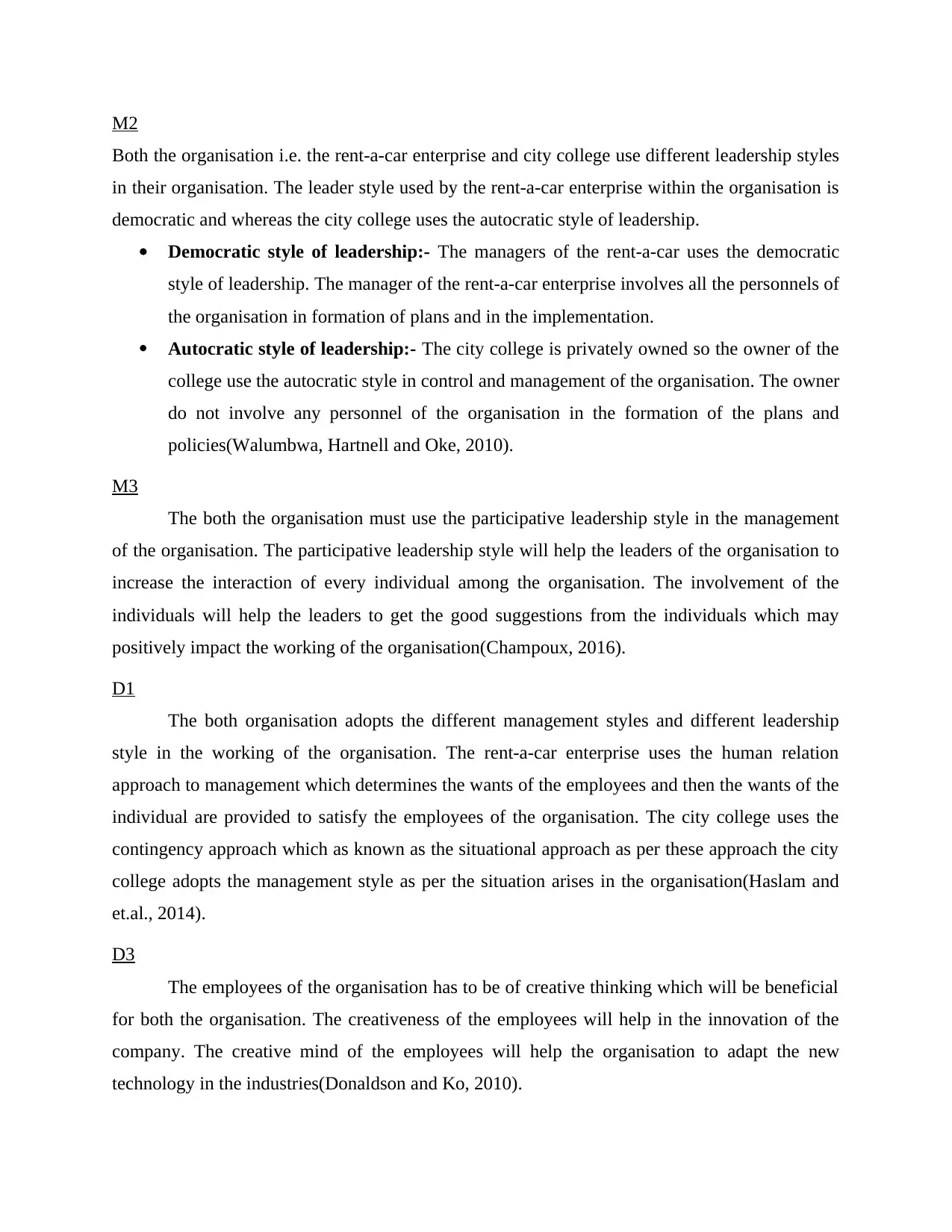
M2
Both the organisation i.e. the rent-a-car enterprise and city college use different leadership styles
in their organisation. The leader style used by the rent-a-car enterprise within the organisation is
democratic and whereas the city college uses the autocratic style of leadership.
Democratic style of leadership:- The managers of the rent-a-car uses the democratic
style of leadership. The manager of the rent-a-car enterprise involves all the personnels of
the organisation in formation of plans and in the implementation.
Autocratic style of leadership:- The city college is privately owned so the owner of the
college use the autocratic style in control and management of the organisation. The owner
do not involve any personnel of the organisation in the formation of the plans and
policies(Walumbwa, Hartnell and Oke, 2010).
M3
The both the organisation must use the participative leadership style in the management
of the organisation. The participative leadership style will help the leaders of the organisation to
increase the interaction of every individual among the organisation. The involvement of the
individuals will help the leaders to get the good suggestions from the individuals which may
positively impact the working of the organisation(Champoux, 2016).
D1
The both organisation adopts the different management styles and different leadership
style in the working of the organisation. The rent-a-car enterprise uses the human relation
approach to management which determines the wants of the employees and then the wants of the
individual are provided to satisfy the employees of the organisation. The city college uses the
contingency approach which as known as the situational approach as per these approach the city
college adopts the management style as per the situation arises in the organisation(Haslam and
et.al., 2014).
D3
The employees of the organisation has to be of creative thinking which will be beneficial
for both the organisation. The creativeness of the employees will help in the innovation of the
company. The creative mind of the employees will help the organisation to adapt the new
technology in the industries(Donaldson and Ko, 2010).
Both the organisation i.e. the rent-a-car enterprise and city college use different leadership styles
in their organisation. The leader style used by the rent-a-car enterprise within the organisation is
democratic and whereas the city college uses the autocratic style of leadership.
Democratic style of leadership:- The managers of the rent-a-car uses the democratic
style of leadership. The manager of the rent-a-car enterprise involves all the personnels of
the organisation in formation of plans and in the implementation.
Autocratic style of leadership:- The city college is privately owned so the owner of the
college use the autocratic style in control and management of the organisation. The owner
do not involve any personnel of the organisation in the formation of the plans and
policies(Walumbwa, Hartnell and Oke, 2010).
M3
The both the organisation must use the participative leadership style in the management
of the organisation. The participative leadership style will help the leaders of the organisation to
increase the interaction of every individual among the organisation. The involvement of the
individuals will help the leaders to get the good suggestions from the individuals which may
positively impact the working of the organisation(Champoux, 2016).
D1
The both organisation adopts the different management styles and different leadership
style in the working of the organisation. The rent-a-car enterprise uses the human relation
approach to management which determines the wants of the employees and then the wants of the
individual are provided to satisfy the employees of the organisation. The city college uses the
contingency approach which as known as the situational approach as per these approach the city
college adopts the management style as per the situation arises in the organisation(Haslam and
et.al., 2014).
D3
The employees of the organisation has to be of creative thinking which will be beneficial
for both the organisation. The creativeness of the employees will help in the innovation of the
company. The creative mind of the employees will help the organisation to adapt the new
technology in the industries(Donaldson and Ko, 2010).
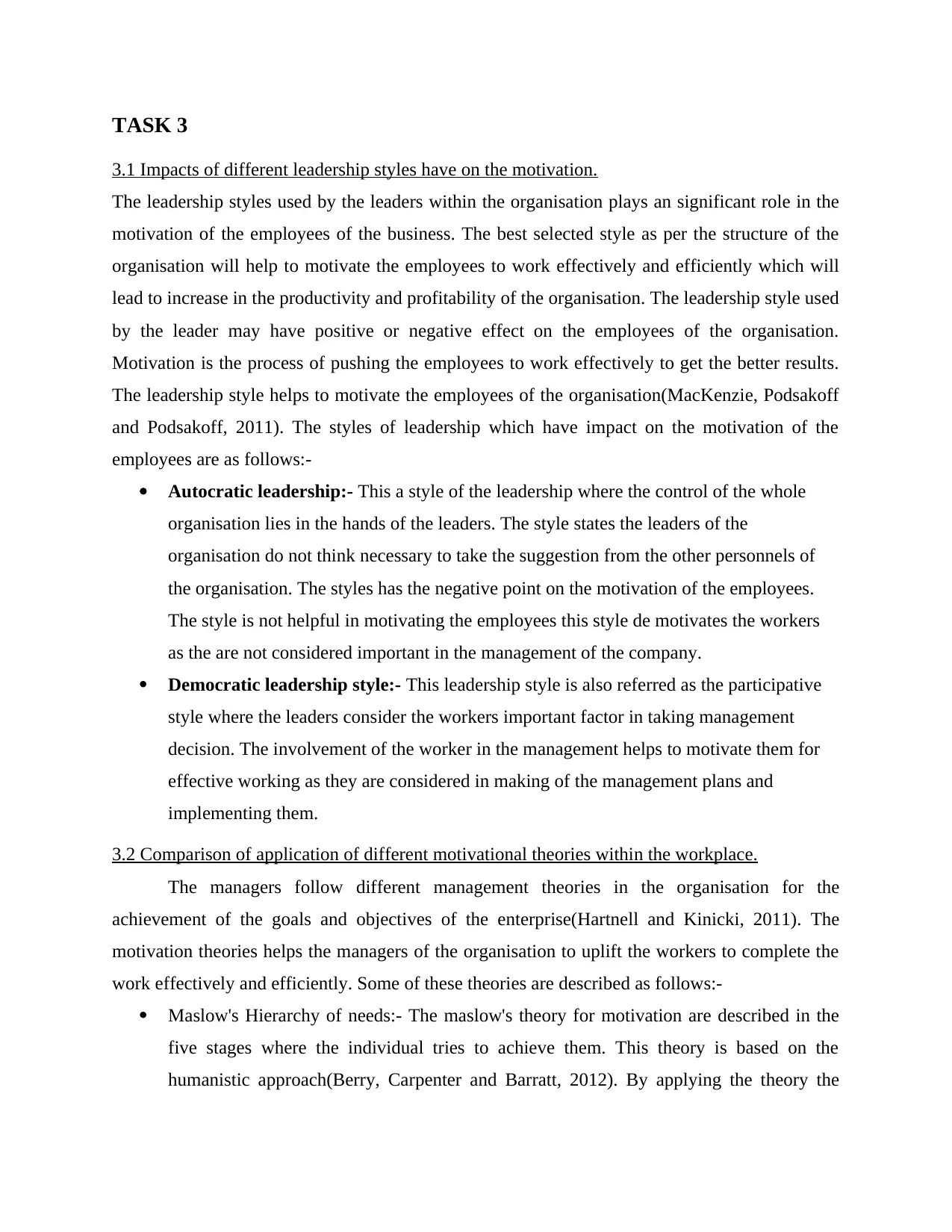
TASK 3
3.1 Impacts of different leadership styles have on the motivation.
The leadership styles used by the leaders within the organisation plays an significant role in the
motivation of the employees of the business. The best selected style as per the structure of the
organisation will help to motivate the employees to work effectively and efficiently which will
lead to increase in the productivity and profitability of the organisation. The leadership style used
by the leader may have positive or negative effect on the employees of the organisation.
Motivation is the process of pushing the employees to work effectively to get the better results.
The leadership style helps to motivate the employees of the organisation(MacKenzie, Podsakoff
and Podsakoff, 2011). The styles of leadership which have impact on the motivation of the
employees are as follows:-
Autocratic leadership:- This a style of the leadership where the control of the whole
organisation lies in the hands of the leaders. The style states the leaders of the
organisation do not think necessary to take the suggestion from the other personnels of
the organisation. The styles has the negative point on the motivation of the employees.
The style is not helpful in motivating the employees this style de motivates the workers
as the are not considered important in the management of the company.
Democratic leadership style:- This leadership style is also referred as the participative
style where the leaders consider the workers important factor in taking management
decision. The involvement of the worker in the management helps to motivate them for
effective working as they are considered in making of the management plans and
implementing them.
3.2 Comparison of application of different motivational theories within the workplace.
The managers follow different management theories in the organisation for the
achievement of the goals and objectives of the enterprise(Hartnell and Kinicki, 2011). The
motivation theories helps the managers of the organisation to uplift the workers to complete the
work effectively and efficiently. Some of these theories are described as follows:-
Maslow's Hierarchy of needs:- The maslow's theory for motivation are described in the
five stages where the individual tries to achieve them. This theory is based on the
humanistic approach(Berry, Carpenter and Barratt, 2012). By applying the theory the
3.1 Impacts of different leadership styles have on the motivation.
The leadership styles used by the leaders within the organisation plays an significant role in the
motivation of the employees of the business. The best selected style as per the structure of the
organisation will help to motivate the employees to work effectively and efficiently which will
lead to increase in the productivity and profitability of the organisation. The leadership style used
by the leader may have positive or negative effect on the employees of the organisation.
Motivation is the process of pushing the employees to work effectively to get the better results.
The leadership style helps to motivate the employees of the organisation(MacKenzie, Podsakoff
and Podsakoff, 2011). The styles of leadership which have impact on the motivation of the
employees are as follows:-
Autocratic leadership:- This a style of the leadership where the control of the whole
organisation lies in the hands of the leaders. The style states the leaders of the
organisation do not think necessary to take the suggestion from the other personnels of
the organisation. The styles has the negative point on the motivation of the employees.
The style is not helpful in motivating the employees this style de motivates the workers
as the are not considered important in the management of the company.
Democratic leadership style:- This leadership style is also referred as the participative
style where the leaders consider the workers important factor in taking management
decision. The involvement of the worker in the management helps to motivate them for
effective working as they are considered in making of the management plans and
implementing them.
3.2 Comparison of application of different motivational theories within the workplace.
The managers follow different management theories in the organisation for the
achievement of the goals and objectives of the enterprise(Hartnell and Kinicki, 2011). The
motivation theories helps the managers of the organisation to uplift the workers to complete the
work effectively and efficiently. Some of these theories are described as follows:-
Maslow's Hierarchy of needs:- The maslow's theory for motivation are described in the
five stages where the individual tries to achieve them. This theory is based on the
humanistic approach(Berry, Carpenter and Barratt, 2012). By applying the theory the
⊘ This is a preview!⊘
Do you want full access?
Subscribe today to unlock all pages.

Trusted by 1+ million students worldwide
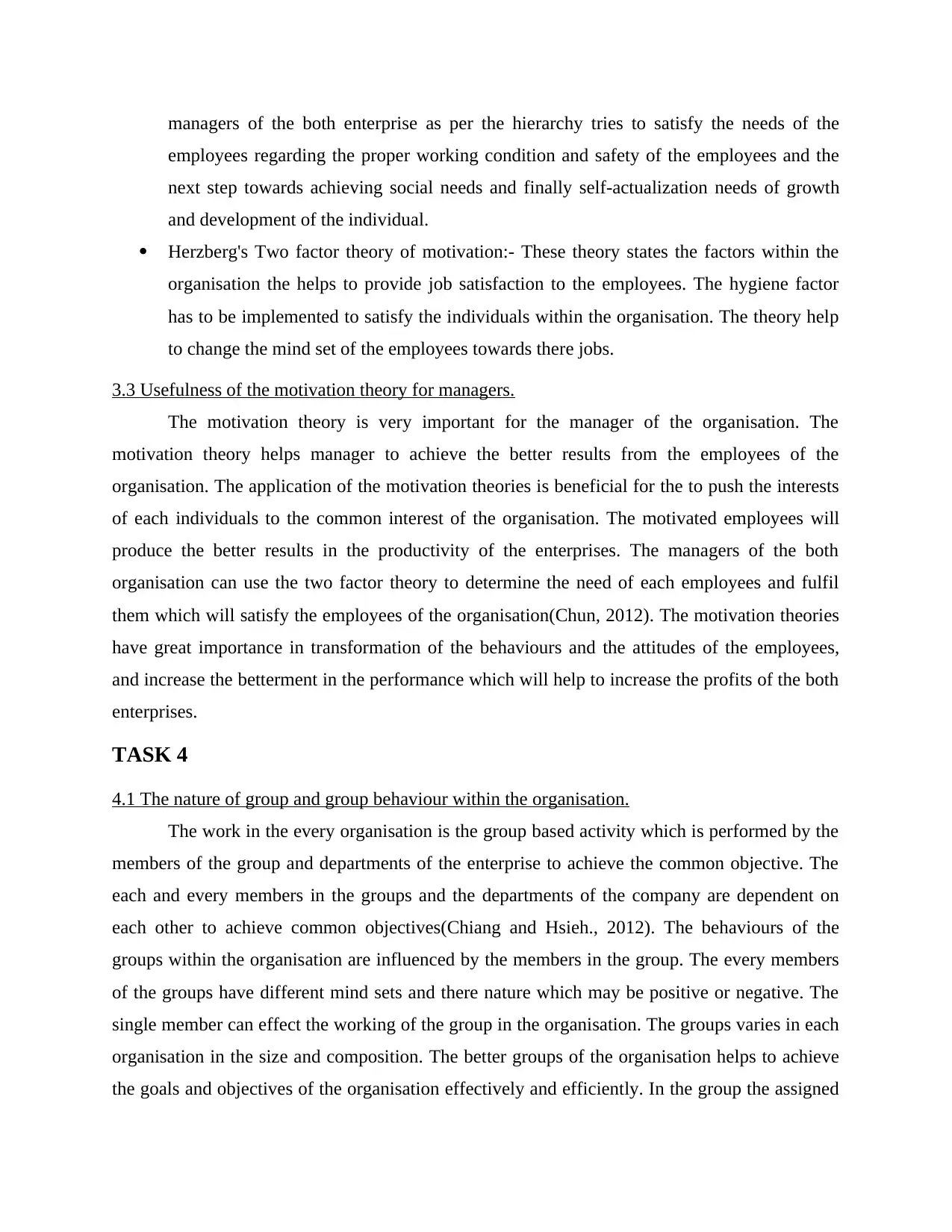
managers of the both enterprise as per the hierarchy tries to satisfy the needs of the
employees regarding the proper working condition and safety of the employees and the
next step towards achieving social needs and finally self-actualization needs of growth
and development of the individual.
Herzberg's Two factor theory of motivation:- These theory states the factors within the
organisation the helps to provide job satisfaction to the employees. The hygiene factor
has to be implemented to satisfy the individuals within the organisation. The theory help
to change the mind set of the employees towards there jobs.
3.3 Usefulness of the motivation theory for managers.
The motivation theory is very important for the manager of the organisation. The
motivation theory helps manager to achieve the better results from the employees of the
organisation. The application of the motivation theories is beneficial for the to push the interests
of each individuals to the common interest of the organisation. The motivated employees will
produce the better results in the productivity of the enterprises. The managers of the both
organisation can use the two factor theory to determine the need of each employees and fulfil
them which will satisfy the employees of the organisation(Chun, 2012). The motivation theories
have great importance in transformation of the behaviours and the attitudes of the employees,
and increase the betterment in the performance which will help to increase the profits of the both
enterprises.
TASK 4
4.1 The nature of group and group behaviour within the organisation.
The work in the every organisation is the group based activity which is performed by the
members of the group and departments of the enterprise to achieve the common objective. The
each and every members in the groups and the departments of the company are dependent on
each other to achieve common objectives(Chiang and Hsieh., 2012). The behaviours of the
groups within the organisation are influenced by the members in the group. The every members
of the groups have different mind sets and there nature which may be positive or negative. The
single member can effect the working of the group in the organisation. The groups varies in each
organisation in the size and composition. The better groups of the organisation helps to achieve
the goals and objectives of the organisation effectively and efficiently. In the group the assigned
employees regarding the proper working condition and safety of the employees and the
next step towards achieving social needs and finally self-actualization needs of growth
and development of the individual.
Herzberg's Two factor theory of motivation:- These theory states the factors within the
organisation the helps to provide job satisfaction to the employees. The hygiene factor
has to be implemented to satisfy the individuals within the organisation. The theory help
to change the mind set of the employees towards there jobs.
3.3 Usefulness of the motivation theory for managers.
The motivation theory is very important for the manager of the organisation. The
motivation theory helps manager to achieve the better results from the employees of the
organisation. The application of the motivation theories is beneficial for the to push the interests
of each individuals to the common interest of the organisation. The motivated employees will
produce the better results in the productivity of the enterprises. The managers of the both
organisation can use the two factor theory to determine the need of each employees and fulfil
them which will satisfy the employees of the organisation(Chun, 2012). The motivation theories
have great importance in transformation of the behaviours and the attitudes of the employees,
and increase the betterment in the performance which will help to increase the profits of the both
enterprises.
TASK 4
4.1 The nature of group and group behaviour within the organisation.
The work in the every organisation is the group based activity which is performed by the
members of the group and departments of the enterprise to achieve the common objective. The
each and every members in the groups and the departments of the company are dependent on
each other to achieve common objectives(Chiang and Hsieh., 2012). The behaviours of the
groups within the organisation are influenced by the members in the group. The every members
of the groups have different mind sets and there nature which may be positive or negative. The
single member can effect the working of the group in the organisation. The groups varies in each
organisation in the size and composition. The better groups of the organisation helps to achieve
the goals and objectives of the organisation effectively and efficiently. In the group the assigned
Paraphrase This Document
Need a fresh take? Get an instant paraphrase of this document with our AI Paraphraser
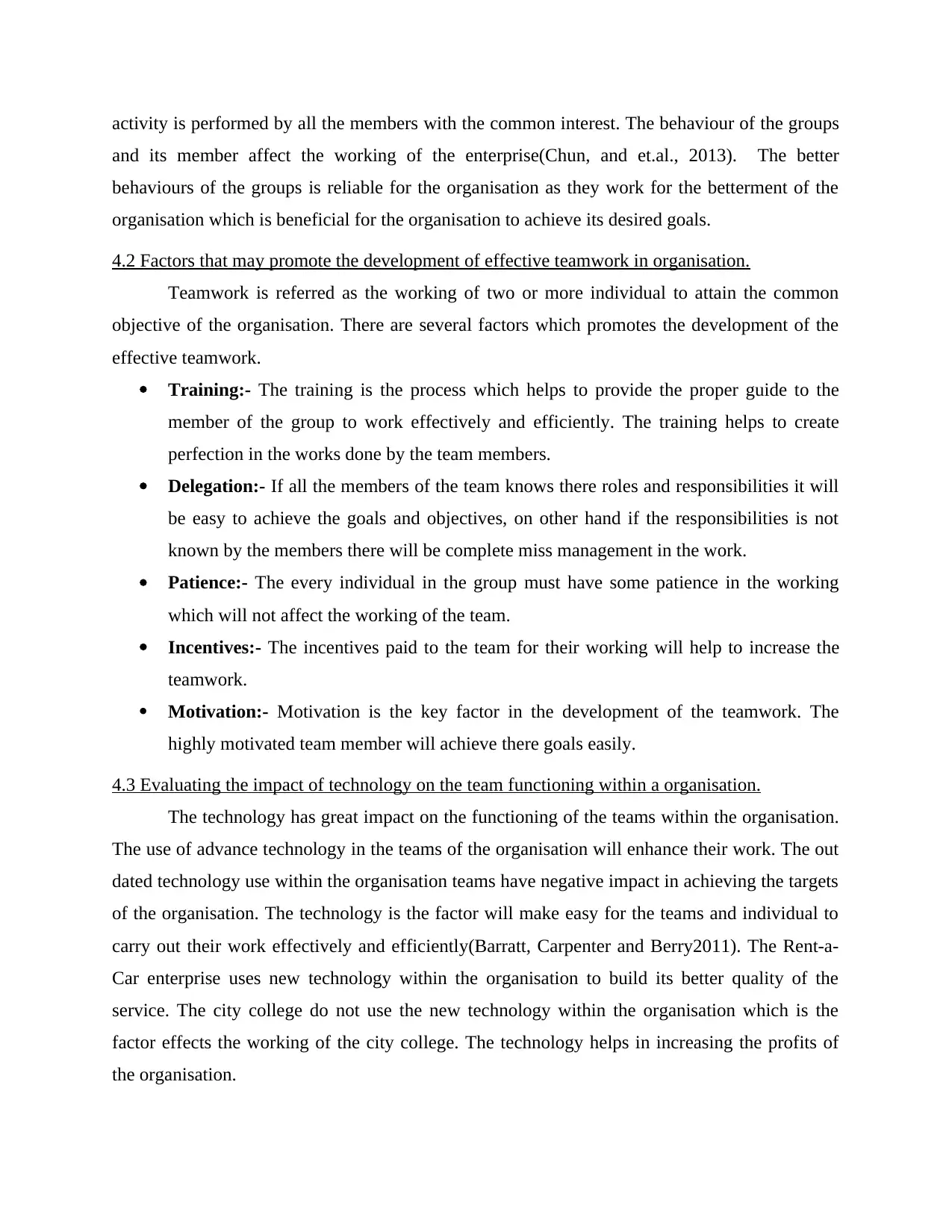
activity is performed by all the members with the common interest. The behaviour of the groups
and its member affect the working of the enterprise(Chun, and et.al., 2013). The better
behaviours of the groups is reliable for the organisation as they work for the betterment of the
organisation which is beneficial for the organisation to achieve its desired goals.
4.2 Factors that may promote the development of effective teamwork in organisation.
Teamwork is referred as the working of two or more individual to attain the common
objective of the organisation. There are several factors which promotes the development of the
effective teamwork.
Training:- The training is the process which helps to provide the proper guide to the
member of the group to work effectively and efficiently. The training helps to create
perfection in the works done by the team members.
Delegation:- If all the members of the team knows there roles and responsibilities it will
be easy to achieve the goals and objectives, on other hand if the responsibilities is not
known by the members there will be complete miss management in the work.
Patience:- The every individual in the group must have some patience in the working
which will not affect the working of the team.
Incentives:- The incentives paid to the team for their working will help to increase the
teamwork.
Motivation:- Motivation is the key factor in the development of the teamwork. The
highly motivated team member will achieve there goals easily.
4.3 Evaluating the impact of technology on the team functioning within a organisation.
The technology has great impact on the functioning of the teams within the organisation.
The use of advance technology in the teams of the organisation will enhance their work. The out
dated technology use within the organisation teams have negative impact in achieving the targets
of the organisation. The technology is the factor will make easy for the teams and individual to
carry out their work effectively and efficiently(Barratt, Carpenter and Berry2011). The Rent-a-
Car enterprise uses new technology within the organisation to build its better quality of the
service. The city college do not use the new technology within the organisation which is the
factor effects the working of the city college. The technology helps in increasing the profits of
the organisation.
and its member affect the working of the enterprise(Chun, and et.al., 2013). The better
behaviours of the groups is reliable for the organisation as they work for the betterment of the
organisation which is beneficial for the organisation to achieve its desired goals.
4.2 Factors that may promote the development of effective teamwork in organisation.
Teamwork is referred as the working of two or more individual to attain the common
objective of the organisation. There are several factors which promotes the development of the
effective teamwork.
Training:- The training is the process which helps to provide the proper guide to the
member of the group to work effectively and efficiently. The training helps to create
perfection in the works done by the team members.
Delegation:- If all the members of the team knows there roles and responsibilities it will
be easy to achieve the goals and objectives, on other hand if the responsibilities is not
known by the members there will be complete miss management in the work.
Patience:- The every individual in the group must have some patience in the working
which will not affect the working of the team.
Incentives:- The incentives paid to the team for their working will help to increase the
teamwork.
Motivation:- Motivation is the key factor in the development of the teamwork. The
highly motivated team member will achieve there goals easily.
4.3 Evaluating the impact of technology on the team functioning within a organisation.
The technology has great impact on the functioning of the teams within the organisation.
The use of advance technology in the teams of the organisation will enhance their work. The out
dated technology use within the organisation teams have negative impact in achieving the targets
of the organisation. The technology is the factor will make easy for the teams and individual to
carry out their work effectively and efficiently(Barratt, Carpenter and Berry2011). The Rent-a-
Car enterprise uses new technology within the organisation to build its better quality of the
service. The city college do not use the new technology within the organisation which is the
factor effects the working of the city college. The technology helps in increasing the profits of
the organisation.
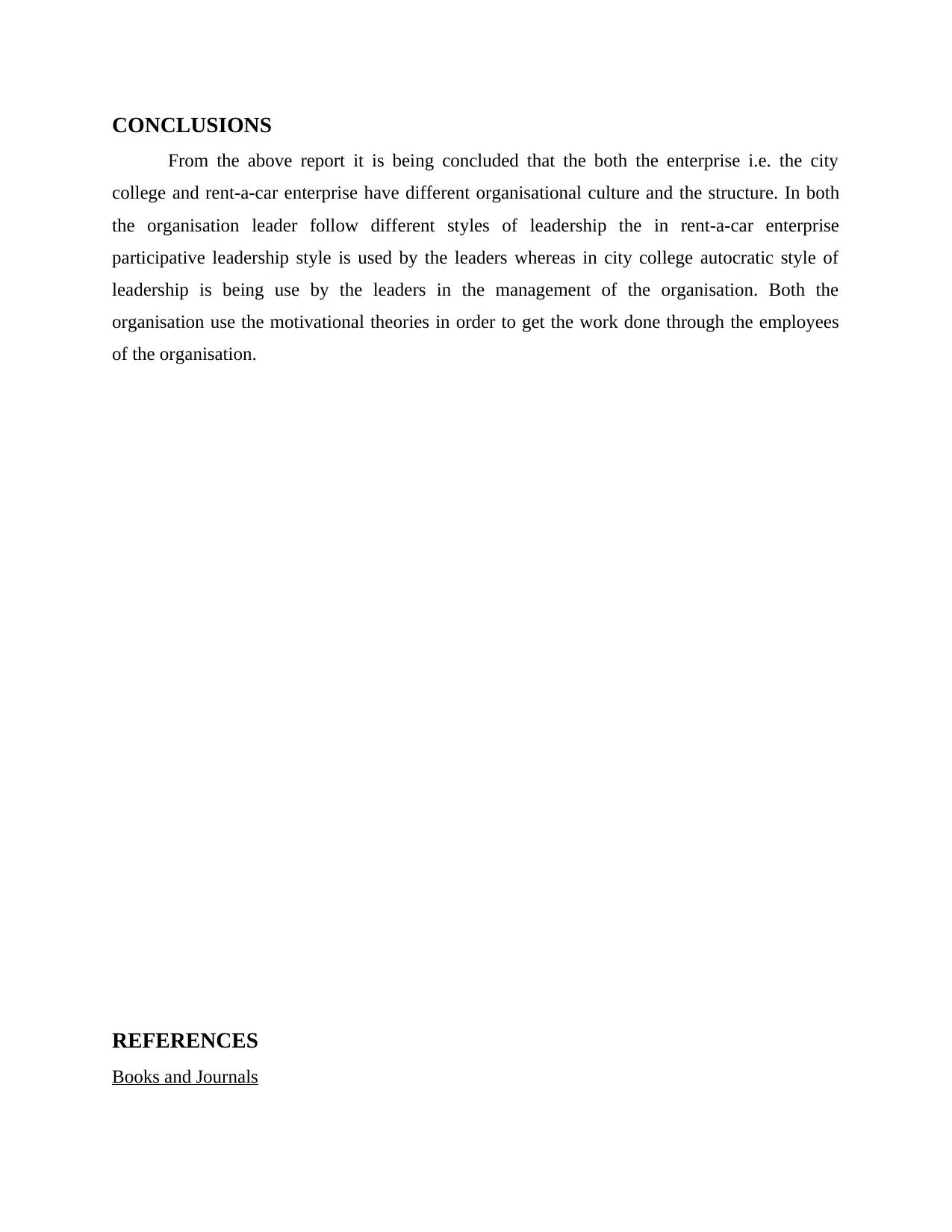
CONCLUSIONS
From the above report it is being concluded that the both the enterprise i.e. the city
college and rent-a-car enterprise have different organisational culture and the structure. In both
the organisation leader follow different styles of leadership the in rent-a-car enterprise
participative leadership style is used by the leaders whereas in city college autocratic style of
leadership is being use by the leaders in the management of the organisation. Both the
organisation use the motivational theories in order to get the work done through the employees
of the organisation.
REFERENCES
Books and Journals
From the above report it is being concluded that the both the enterprise i.e. the city
college and rent-a-car enterprise have different organisational culture and the structure. In both
the organisation leader follow different styles of leadership the in rent-a-car enterprise
participative leadership style is used by the leaders whereas in city college autocratic style of
leadership is being use by the leaders in the management of the organisation. Both the
organisation use the motivational theories in order to get the work done through the employees
of the organisation.
REFERENCES
Books and Journals
⊘ This is a preview!⊘
Do you want full access?
Subscribe today to unlock all pages.

Trusted by 1+ million students worldwide
1 out of 14
Related Documents
Your All-in-One AI-Powered Toolkit for Academic Success.
+13062052269
info@desklib.com
Available 24*7 on WhatsApp / Email
![[object Object]](/_next/static/media/star-bottom.7253800d.svg)
Unlock your academic potential
Copyright © 2020–2025 A2Z Services. All Rights Reserved. Developed and managed by ZUCOL.





